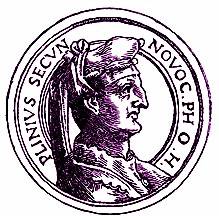The Romans were a practical people. Agriculture and horticulture were developed and well-tended. To get through cold periods without damage, for example, plants were grown under glass in patches that were enriched in manure. They also covered upper parts of plants in order to protect them against frost. PLINY writes that it was possible, due to these methods, to harvest cucumbers throughout the year. M. PORCIUS CATO mentiones six different varieties of pears, several varieties of apples and quinces and some varieties of grapevine of different origins in his work on agriculture. Three varieties of cabbage were known.
The best-known Roman author dealing with plants, was DIOSKORIDE. For more than sixteen centuries he was supposed to be the superior authority in pharmacology. His work was illustrated and this was widely attacked by PLINY and others. PLINY criticized wrong colors, differences in the abilities of the painters who did the copying and the fact that the look of plants changes through the course of the year. It was not before the invention of letterpress that drawings gained real importance as a means of representing observations.
DIOSKORIDE's work cannot be compared to that of THEOPHRASTUS. It pays almost no regard to general botany, though THEOPHRASTUS describes about 500 different plant species and thereby leaves the widest list of plants of antiquity.
 |
PLINY THE OLDER [= PLINIUS SECUNDUS; 23 BC (Como)-79 (Pompeji)] is another author, who wrote about topics of natural sciences. He published a work on natural history that paid only little attention to botany. Moreover, he looked at plants only from the point of view of utility. He starts with a description of trees, not because he ranks them highest (as THEOPHRASTUS does), but because they fulfill the fundamental needs of human beings. Laurel is reviewed because its twigs are needed for triumphal processions. In the following, desciptions of grapevine, agricultural crops, vegetables and ornamental plants are given. Since many ornamental plants are also sources of food for bees, bee plants are treated next. First the recommendable ones are mentioned, then those that spoil the honey. They are followed by wildgrowing plants which are either beautiful or smell good and by edible and medicinal plants. At the end of the book is a list of plants in alphabetical order. Some of PLINY's passages are -poorly- borrowed from THEOPHRASTUS. |
|
|